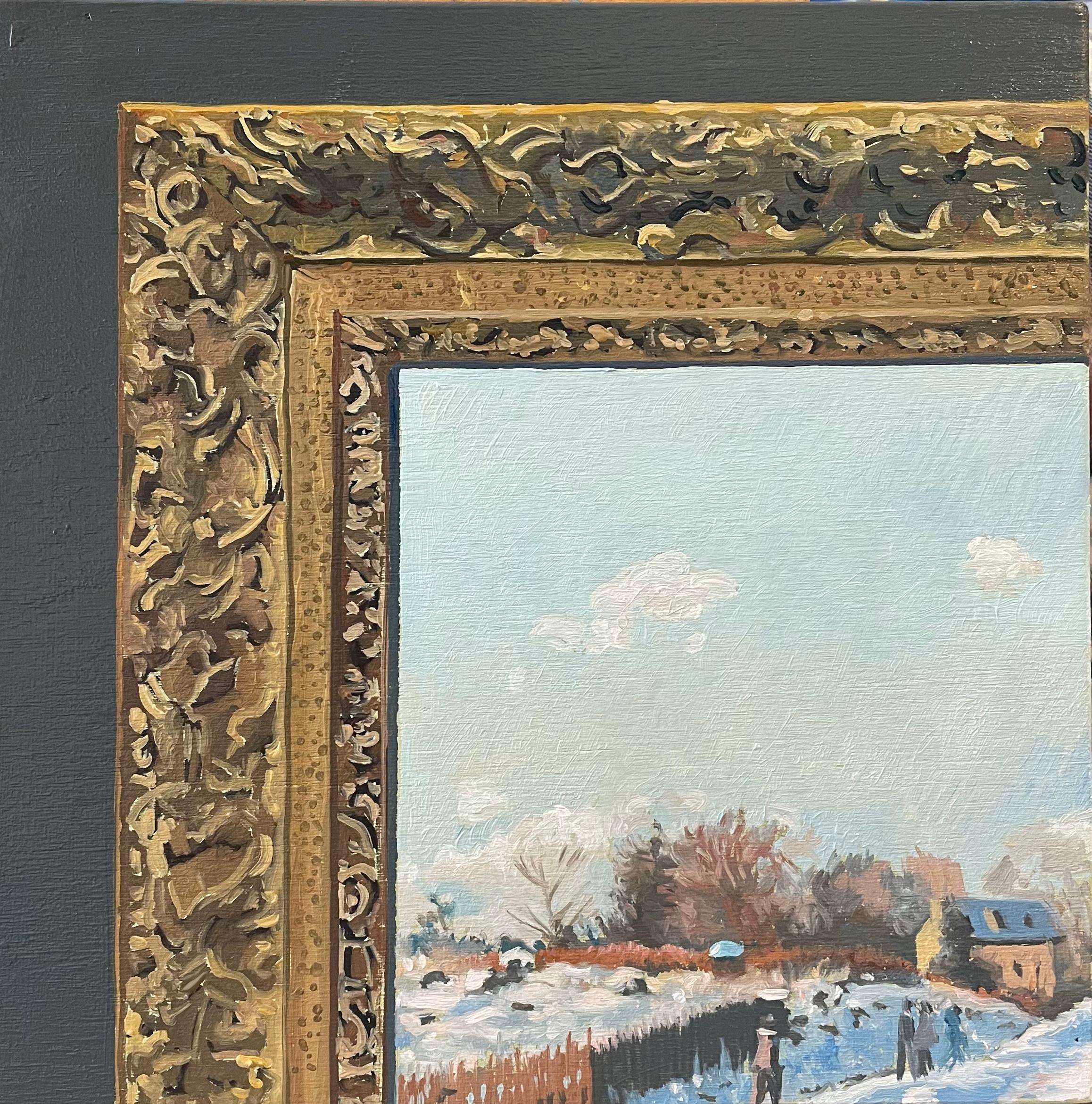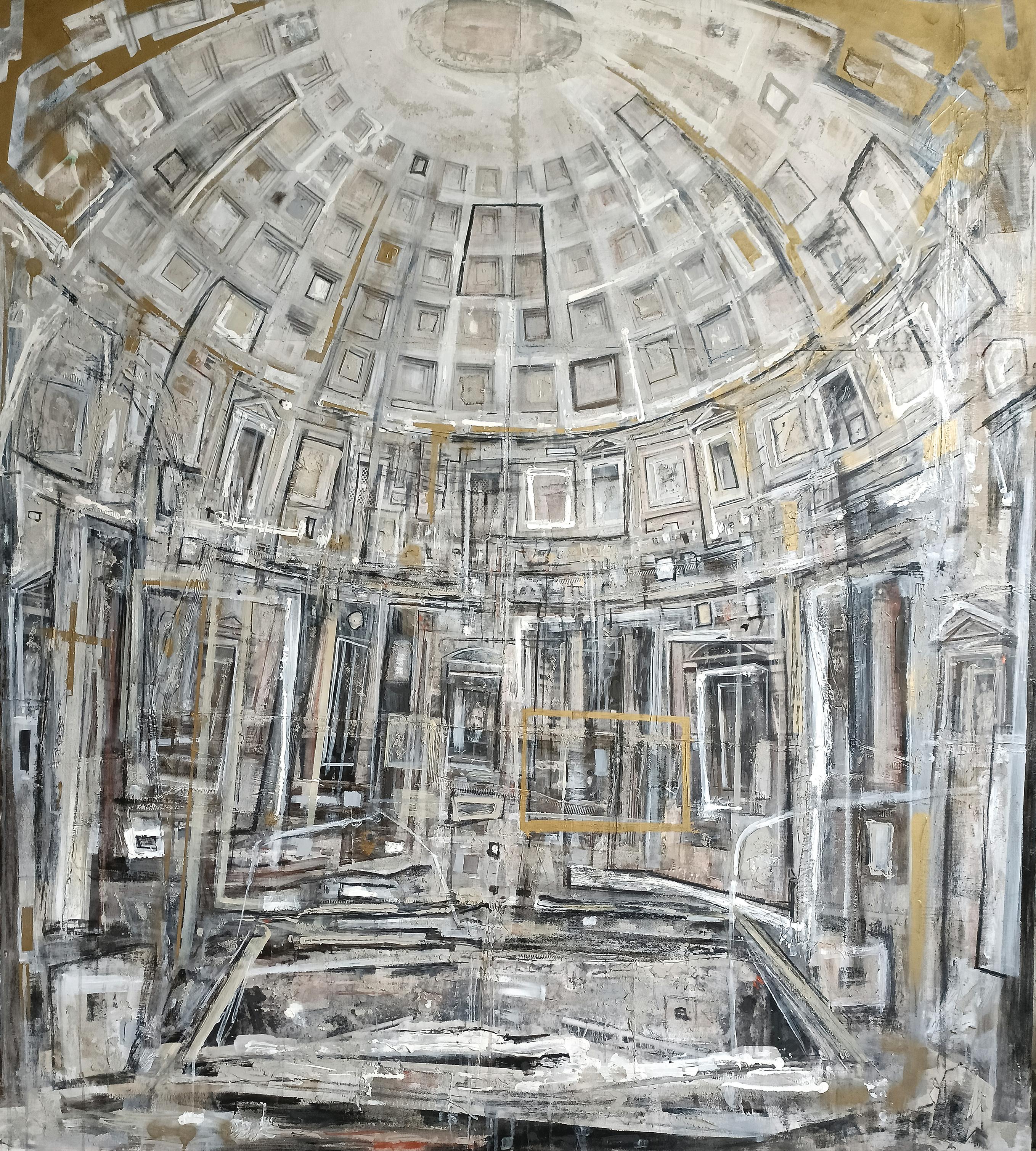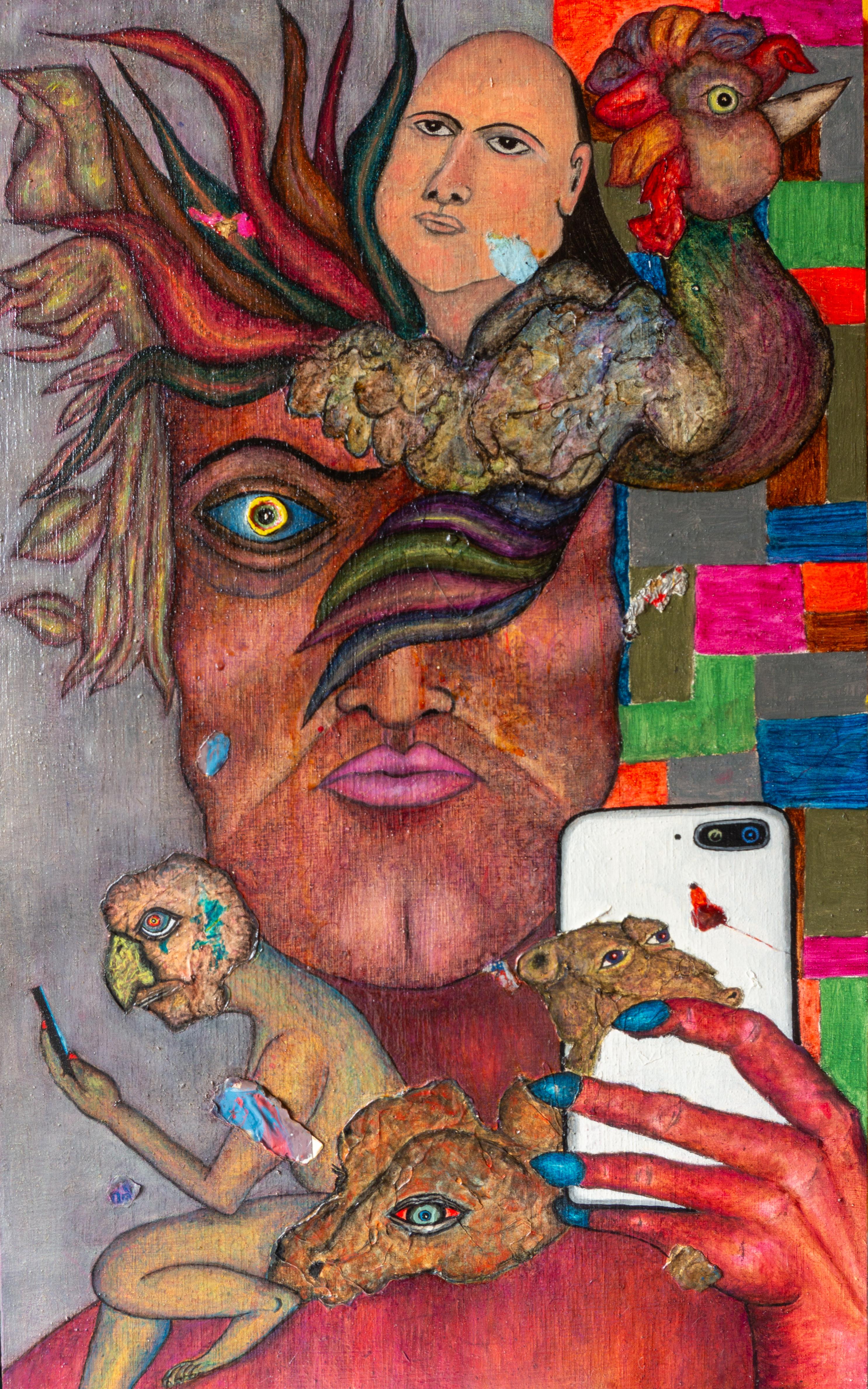Items Similar to Sea Gods
Want more images or videos?
Request additional images or videos from the seller
1 of 9
Michael ToleSea Gods2022
2022
About the Item
Michael Tole says of his work…
My conservative, Church of Christ grandmother lived in a pristine little mid-century modern house in the middle-of-no-where, Texas. Its trim, Protestant exterior belied a decadent mishmash of sculpted chocolate carpeting, and gold gilt Rococo furnishings inside. Strewn about the living room walls were frothy little reproductions of pearly, 18th century goddesses frolicking amid forests and streams--mocking the clean modern lines of the room. These prints of Bouchers and Fragonards were so pretty, so decorative, so innocuous in their style that it didn’t occur to me until years later when I studied them in college that they were lesbian love scenes. In these anodyne fetes, young women roiled, breasts and bottoms abounding, gazed into one another's doe eyes, and caressed fulsome cheeks. Though overtly erotic, their style was so decorative and soft that even my religiously conservative grandmother experienced no cognitive dissonance between the racy content and her religious beliefs. I find this tension between style and content, fascinating. The trio of paintings: The Summit of the Gods, Sea Gods, and Modern Marlowe are an exploration of it. I am unaware of any equivalent all male scenes from the Rococo period. This appears to be an inherent bias within the tradition. With this work, I am trying to pry open the tradition and make a space the male figure as decorative--pretty. I say "pretty" instead of "beautiful" because the "beautiful" can be threatening or challenging. "Pretty" is a term we generally apply to unambiguously attractive, comforting, and accepted things: flowers, puppies, babies, etc. I want to know if men can be pretty in the same way those 18th century goddesses are. I think I’ve made a pretty good visual argument for that perception. I'll know I've succeeded if the next generation of grandmas can host their women's bible study group in a living room hung with these paintings.
My grandmother likely bought these prints at about the time John Berger coined the truism: “Men act and women appear.” In one sense, this painting is asking if it is possible for men simply to appear, without a narrative justification. The mythological titles of this trio are intentionally vague enough to let the images reside mostly in a non-narrative context, placing emphasis on its aesthetics, not its story.
In my current work, The Revisionist Histories, I am writing letters to art history, literature, and mythology in an attempt to reflect the social changes that have reshaped our society over the past century. As part of this agenda, I explore the evolution of gender norms, power dynamics, and representation within Western visual culture and what this implies for the negotiation between pleasure, justice, and our culturally specific discourse on beauty.
The seed for The Revisionist Histories was sewn when I caught a glimpse of my preteen daughters watching music videos on their iPad as I chopped veggies for dinner. Out of the corner of my eye I caught glimpses of music videos featuring Beyonce, Taylor Swift, Ariana Grande, Katy Perry, and Doja Cat gyrating across the tiny screen. A better parent might have snatched the iPad away, but I was overcome with hallucinatory visions of this pop diva pantheon dancing through the painted ceilings of Versailles and countless Bavarian Chapels. Watching these videos, I observed that they employed an aesthetic that rested comfortably within Baroque and Rococo parameters, exhibiting chiaroscuro, ostentatious displays of wealth, over-the-top emotionalism, fantasy, self-aggrandizement, pastel color schemes, gender fluidity (a trait more Rococo than Baroque), and heaping piles of conventionally attractive young women in provocative poses. The new themes of female agency, diversity, and inclusivity were unquestionably positive additions to Western visual culture, yet some of the similarities between Katy Perry and Fragonard seemed to merit further consideration. Since that initial revelation, my research has expanded to include the entire fantasy industrial complex, from Hollywood and Las Vegas, to advertising and social media. Through their conflation of art history, mythology, literature, and pop culture, these paintings attempt to sus out the implications of the observable ascendancy of a fantastical, luxuriating Rococo-esque aesthetic in our contemporary visual media.
We may not normally consider the genre of teen pop music videos and TikTok posts to be fodder for philosophical reflection, but the fantasies they create reveal truths about us, and those truths deserve our conscious consideration. To explore this, I set out on a mission to master Baroque and Rococo pictorial rhetoric, believing it to be the best vehicle to explore the continuity and disjuncture between 18th and 21st century Western visual culture. I intend to create paintings that can hang side by side with old master works in a museum that, viewed at a glance, do not stand out from their neighbors, but upon further inspection begin to reveal to the viewer those aspects of culture that have evolved, and those that have remained the same over centuries, inviting comparison, analysis, introspection, and perhaps a chuckle.
⎯⎯⎯⎯⎯
Michael Tole is a figurative painter currently living in Tempe, AZ with his wife and two daughters. Born in 1979 in Dallas, Texas, he graduated from UT Austin with a BFA in painting in 2000. A year later, he became the youngest artist ever represented by Dallas’ Conduit Gallery where he showed for 15 years. For the first half of his career, he created photo-based paintings of retail interiors that explored issues of class, and the relationship of painting and photography. After relocating to Tempe, his work experienced a significant shift to fantastical figurative inventions based on pop culture imagery he has encountered via his two daughters’ taste in music videos, and his new proximity to the twin capitals of America’s fantasy industrial complex--Hollywood and Las Vegas. The new work attempts to contextualize their brand of Disney-esque hedonism within a broader historical view of Western visual culture. Mr. Tole’s career includes shows in New York, Los Angeles, San Francisco, Dallas, and New Orleans. He has won several grants, including the $50,000 Hunting Art Prize, and the Kimbrough Grant. His work has been reviewed in Art Forum International, San Francisco Chronicle, and Dallas Morning News.
- Creator:Michael Tole (American)
- Creation Year:2022
- Dimensions:Height: 18 in (45.72 cm)Width: 24 in (60.96 cm)
- Medium:
- Movement & Style:
- Period:
- Framing:Framing Options Available
- Condition:
- Gallery Location:New Orleans, LA
- Reference Number:1stDibs: LU105210994852
About the Seller
5.0
Gold Seller
These expertly vetted sellers are highly rated and consistently exceed customer expectations.
Established in 1998
1stDibs seller since 2015
139 sales on 1stDibs
Typical response time: <1 hour
- ShippingRetrieving quote...Ships From: New Orleans, LA
- Return PolicyA return for this item may be initiated within 3 days of delivery.
More From This SellerView All
- Elipse 2Located in New Orleans, LAMichael Tole is a figurative painter currently living in Tempe, AZ with his wife and daughters. A Texas native, most of his 20 year long career was spent...Category
21st Century and Contemporary Contemporary Figurative Paintings
MaterialsPanel, Oil
- Elipse 1Located in New Orleans, LAMichael Tole is a figurative painter currently living in Tempe, AZ with his wife and daughters. A Texas native, most of his 20 year long career was spent in Dallas. After relocating to Tempe, his work experienced a significant shift from photo-based paintings of retail interiors to fantastical figurative inventions based on pop culture imagery he has encountered via his two daughters’ taste in music videos, and his proximity to Southern California and it’s particular brand of Disney-esque hedonism. Mr. Tole’s career includes shows in New York, Los Angeles, San Francisco, Dallas, and Miami. His work has been reviewed in Art Forum International...Category
21st Century and Contemporary Contemporary Figurative Paintings
MaterialsOil, Panel
- SaluteBy Nora SeeLocated in New Orleans, LA"Salute" is a salute to the Black Power Salute used as a political demonstration by African-American athletes John Carlos and Tommie Smith during their med...Category
2010s Contemporary Figurative Paintings
MaterialsPanel, Oil
- Modern MarloweLocated in New Orleans, LAMichael Tole says of his work… My conservative, Church of Christ grandmother lived in a pristine little mid-century modern house in the middle-of-no-where, Texas. Its trim, Protestant exterior belied a decadent mishmash of sculpted chocolate carpeting, and gold gilt Rococo furnishings inside. Strewn about the living room walls were frothy little reproductions of pearly, 18th century goddesses frolicking amid forests and streams--mocking the clean modern lines of the room. These prints of Bouchers and Fragonards were so pretty, so decorative, so innocuous in their style that it didn’t occur to me until years later when I studied them in college that they were lesbian love scenes. In these anodyne fetes, young women roiled, breasts and bottoms abounding, gazed into one another's doe eyes, and caressed fulsome cheeks. Though overtly erotic, their style was so decorative and soft that even my religiously conservative grandmother experienced no cognitive dissonance between the racy content and her religious beliefs. I find this tension between style and content, fascinating. The trio of paintings: The Summit of the Gods, Sea Gods, and Modern Marlowe are an exploration of it. I am unaware of any equivalent all male scenes from the Rococo period. This appears to be an inherent bias within the tradition. With this work, I am trying to pry open the tradition and make a space the male figure as decorative--pretty. I say "pretty" instead of "beautiful" because the "beautiful" can be threatening or challenging. "Pretty" is a term we generally apply to unambiguously attractive, comforting, and accepted things: flowers, puppies, babies, etc. I want to know if men can be pretty in the same way those 18th century goddesses are. I think I’ve made a pretty good visual argument for that perception. I'll know I've succeeded if the next generation of grandmas can host their women's bible study group in a living room hung with these paintings. My grandmother likely bought these prints at about the time John Berger coined the truism: “Men act and women appear.” In one sense, this painting is asking if it is possible for men simply to appear, without a narrative justification. The mythological titles of this trio are intentionally vague enough to let the images reside mostly in a non-narrative context, placing emphasis on its aesthetics, not its story. In my current work, The Revisionist Histories, I am writing letters to art history, literature, and mythology in an attempt to reflect the social changes that have reshaped our society over the past century. As part of this agenda, I explore the evolution of gender norms, power dynamics, and representation within Western visual culture and what this implies for the negotiation between pleasure, justice, and our culturally specific discourse on beauty. The seed for The Revisionist Histories was sewn when I caught a glimpse of my preteen daughters watching music videos on their iPad as I chopped veggies for dinner. Out of the corner of my eye I caught glimpses of music videos featuring Beyonce, Taylor Swift, Ariana Grande, Katy Perry, and Doja Cat gyrating across the tiny screen. A better parent might have snatched the iPad away, but I was overcome with hallucinatory visions of this pop diva...Category
21st Century and Contemporary Contemporary Figurative Paintings
MaterialsOil, Panel
- The Evidence of Things SeenBy Chris BarnardLocated in New Orleans, LAAn abstracted view of the Art Institute of Chicago's Grand Staircase. The lone sculpture fictionally represents an armed officer pointing a gun at an absent figure. [b. 1977 – New York, NY ::: lives & works – New Haven, CT] CHRIS BARNARD received his BA from Yale and his MFA from The University of Southern California (USC) in Los Angeles. Having previously held faculty positions at Denison University, Indiana University, and USC, Barnard is currently associate professor of art at Connecticut College in New London. Barnard’s work has been shown in solo and group exhibitions in Los Angeles, New York, Chicago, and New Haven, among other locations, and can be found in public and private collections nationally and internationally. His work is represented by Fred Giampietro Gallery in New Haven, where he and his partner live. artist statement In my work I focus on white supremacy’s relationship to the privileged spaces of my experiences, such as private art and educational institutions. Amidst widening gaps in wealth and opportunity, discussions about race, power, justice and representation—across visual culture broadly—seem more relevant than ever. In many of my compositions, which reference real sites, I have inserted fictional elements to raise questions about the allegiances and priorities of these institutions, as well as people—including myself—who have benefitted from, or continue to support them. The resulting works are representational, but through gestural passages and color and surface manipulation, I aim to suggest instability, corrosion and decay. In the end, I strive to make engaging paintings that suggest dissonance and ambivalence, that entice and challenge viewers, just as painting them does for me. These paintings are rooted in my contemplating Whiteness and emerge from wrestling with the politics of painting—the connections and gaps between painting and lived experience. They also reflect: a love of paint, the act of painting, and the power of the painted image; a regard for practitioners past and present, as well as those for whom practice has not been possible; and an admission of painting’s complicity with hegemonic power. As always, my process remains driven by questions. In this case, questions like: What role does painting play in the face of concrete social crises? How can my paintings respectfully incorporate¬—rather than exploit—relevant and thought-provoking content and imagery? What does it mean to think about racism, dehumanization, injustice, etc., and then to paint such pictures, and in particular as a straight, White man? These questions and this body of work owe much to the work of others, and most acutely to four scholars’ books in particular: The History of White People, by Nell Irvin Painter; Ebony and Ivy: Race, Slavery, and the Troubled History of America’s Universities by Craig Steven Wilder; The New Jim Crow: Mass Incarceration in the Age of Colorblindness, by Michelle Alexander; and White Rage, by Carol Anderson...Category
21st Century and Contemporary Contemporary Figurative Paintings
MaterialsCanvas, Oil, Panel
- "The Sunset" -- Oil Painting by Alexander StolinLocated in New Orleans, LAALEXANDER STOLIN, born and raised in Kiev, Ukraine (under the former Soviet Socialist Republic), where he received intensive training and a master of fine arts degree in his homeland...Category
21st Century and Contemporary Contemporary Figurative Paintings
MaterialsOil, Wood Panel
You May Also Like
- Corner of AS, Original Oil Painting, LandscapeBy Raphaël RenaudLocated in AIX-EN-PROVENCE, FRWork : Original Oil Painting, Handmade Artwork, Unique Work. Ready to Hang. Medium : Oil on coated wood. Artist : Raphaël Renaud Subject : Coin de AS (Title), (EN : Corner of AS). T...Category
21st Century and Contemporary Contemporary Interior Paintings
MaterialsOil, Wood Panel
- Torre VelascaLocated in Milano, MIUrbex is the English acronym for urban exploration and is an activity that consists of searching for and locating abandoned infrastructure with the goal of visiting, photographing and conveying its contents, with particular involvement of methodologies from geography, anthropology, sociology to cultural studies. Her works have been in the past approached to the works of Anselm Kiefer (b. 1945) and Giovanni Battista Piranesi (1720-1770), but in Gullotta's paintings the absence of color makes the spaces particularly ethereal, allowing them to be ideally lifted to new places and to new life. An artist of international caliber who has decided to entrust her return to her homeland to Almach Art Gallery in Milan, while maintaining connections with important galleries, such as Marlborough Fine Art in London and Galerie Koch in Hanover. The artwork represents the famous Velasca Tower in Milan. This artwork was exhibited during the Daniela Gullotta...Category
2010s Contemporary Portrait Paintings
MaterialsSandstone
- PantheonLocated in Milano, MIUrbex is the English acronym for urban exploration and is an activity that consists of searching for and locating abandoned infrastructure with the goal of visiting, photographing and conveying its contents, with particular involvement of methodologies from geography, anthropology, sociology to cultural studies. Her works have been in the past approached to the works of Anselm Kiefer (b. 1945) and Giovanni Battista Piranesi (1720-1770), but in Gullotta's paintings the absence of color makes the spaces particularly ethereal, allowing them to be ideally lifted to new places and to new life. An artist of international caliber who has decided to entrust her return to her homeland to Almach Art Gallery in Milan, while maintaining connections with important galleries, such as Marlborough Fine Art in London and Galerie Koch in Hanover. The artwork represents the famous Velasca Tower in Milan. This artwork was exhibited during the Daniela Gullotta...Category
2010s Contemporary Portrait Paintings
MaterialsSandstone
- A SecretLocated in Bogotá, BogotáFigurative Magical Painting, textured mixed technique, created in 2021. This piece represents one of my earlier works, exploring our connection with animals through a human and magic...Category
2010s Contemporary Portrait Paintings
MaterialsOil, Wood Panel
- GardenLocated in Bogotá, BogotáTextured mixed technique, 2021 Figurative Magical Painting. This is one of my early works, where I delve deeper into our connection with animals through a human and magical lens. Ani...Category
2010s Contemporary Figurative Paintings
MaterialsOil, Wood Panel
- French Contemporary Art by M.-P. Autonne - Heureuse MélancolieBy Marie-Pierre AutonneLocated in Paris, IDFAcrylic and oil on wooden panelCategory
2010s Contemporary Abstract Paintings
MaterialsOil, Acrylic, Wood Panel





